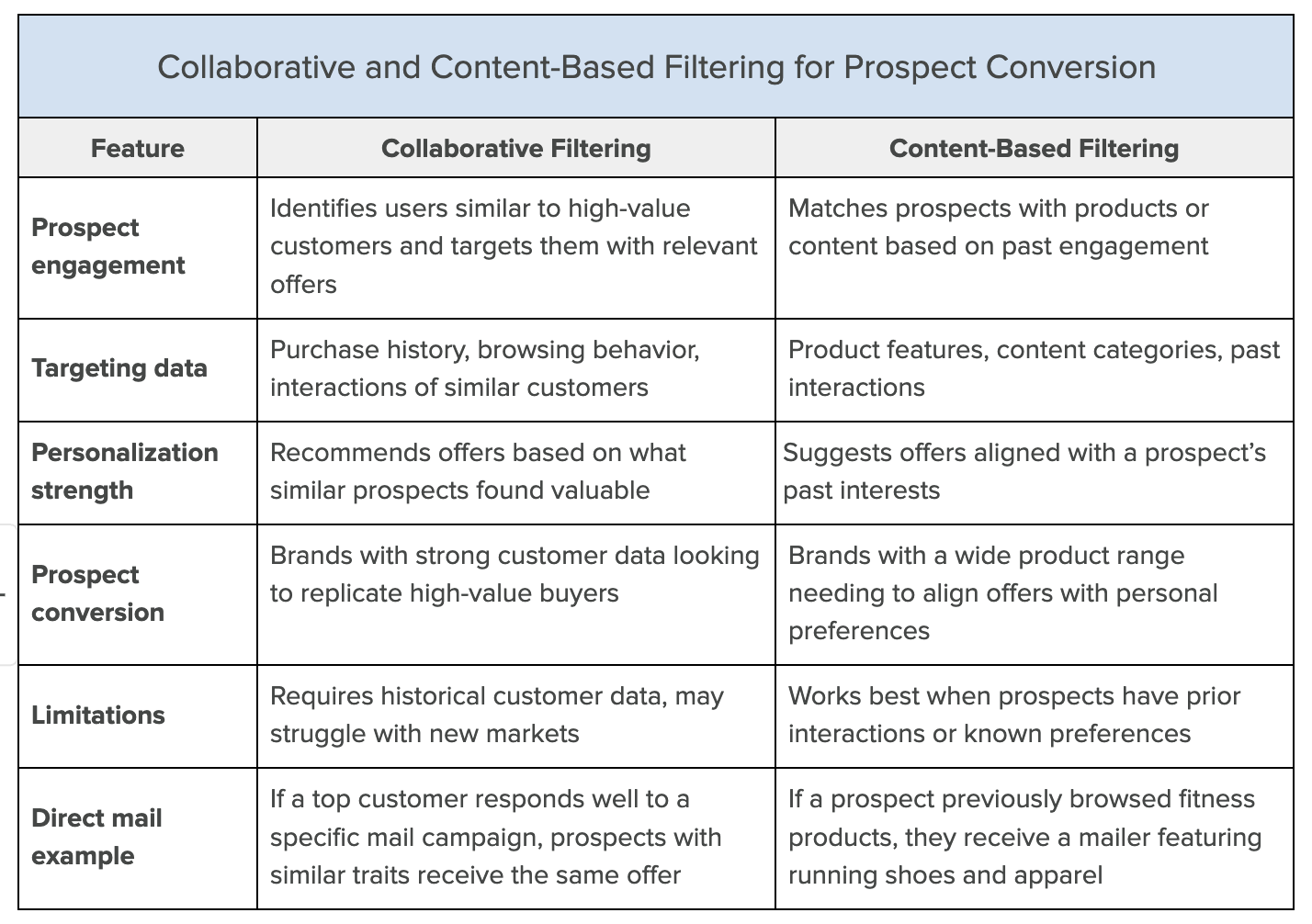Direct mail is a powerful tool, but traditional prospecting methods often fall short. Many marketers still rely on the same approach: sending mail to as many people in a ZIP code as possible and hoping it lands with the right audience. There’s no real effort to understand what actually drives someone to take action. It’s an outdated strategy that stretches budgets thin and lowers response rates.
Old-school targeting won’t cut it, but data-driven audience modeling will. Lookalike audiences and machine learning give direct mail the same level of precision and profitability as digital marketing.
How Lookalike Audiences Make Direct Mail More Effective
Marketers looking to boost conversion rates often build lookalike audiences based on their best customers found within heir first part data. These profiles reveal key insights, helping brands reach people who mirror their top buyers. It expands reach and boosts the chances of conversion. Here’s how it works.
Fine-Tuning Data Models for Better Prospect Targeting
Prebuilt data models don’t always get it right. They can miss high-value prospects or rely too heavily on a single data source. To improve accuracy, marketers need to combine first- and third-party data, and continuously calibrate individual data models before blending insights across providers.
Each data source offers a different perspective, but no single model tells the whole story. One might rank a prospect highly based on past purchase behavior, while another—relying on demographic attributes—scores them lower. When that prospect converts, it signals which data points actually influenced engagement. Calibration helps refine scoring over time, allowing models to adapt to real-world results.
Without ongoing adjustments, models can lose accuracy as campaigns scale. Using multiple independent data models instead of blending too soon reduces this risk, allowing marketers to test and compare different data sources. This process highlights the most predictive signals and eliminates noise, improving prospect selection without sacrificing reach.
Refining data models isn’t a one-and-done process, it’s an ongoing adjustment that keeps up with shifting consumer behavior. The payoff is smarter prospect selection, stronger campaign results, and higher returns on direct mail investments.
Blended Data Creates Strong Lookalike Audiences
Not all lookalike audiences are created equal. The strongest ones go beyond basic demographics and incorporate multiple data points to build a precise customer profile.
Marketers need to analyze:
- Demographics: Age, income, education, household composition
- Geographic data: Regional trends, neighborhood preferences
- Behavioral data: Purchase history, website visits, engagement patterns
- Psychographics: Interests, values, lifestyle choices
- Financial data: Spending patterns, credit attributes
To build a strong lookalike audience profile, marketers start with a broad source audience before refining it for higher accuracy and better ROI. The challenge lies in narrowing this audience while maintaining enough reach to drive conversions. More precise lookalike audiences often deliver stronger performance, as they focus on prospects more likely to engage and convert.
Combining first-party CRM data with third-party insights from data providers like Acxiom, Epsilon, and Experian helps sharpen these audience profiles. Layering additional data points refines targeting, ensuring campaigns prioritize high-intent, high-value prospects instead of casting too wide a net.
How a Top Brand Used Lookalike Audiences to Drive Higher Conversions
A national apparel brand shifted from broad ZIP-code targeting to data-driven audience selection using Postie’s lookalike modeling. Rather than rely on generic mailings, they used machine learning to analyze their best customers and identify high-value prospects with similar traits. Refined targeting helped them focus on the right prospects and cut wasteful spending.
The brand’s lookalike audience strategy produced impressive results:
- 408% ROAS from their direct mail campaign
- Lower CPA, outperforming initial benchmarks
- Increased engagement & repeat purchases, proving audience quality beats audience size
Beyond better targeting, lookalike modeling gave the brand a scalable strategy for continuous growth. With more precise audience selection, they expanded their reach while maintaining high conversion rates and a strong return on ad spend.
Using Machine Learning for Smarter Direct Mail Targeting
Blending first- and third-party data without a layer of machine learning is a great recipe for your best prospects to slip through the cracks. Fortunately, AI spots hidden patterns that traditional methods miss.
One way this happens is through supervised learning models, which analyze past behavior to predict who’s most likely to engage. Recent purchase data further sharpens personalization, helping intelligent algorithms generate tailored offers—like product recommendations—that drive higher response rates. Beyond personalization, these techniques also refine audience selection, ranking the best prospects with greater accuracy.
Machine Learning Techniques that Improve Lookalike Audiences
No single machine learning technique works in isolation. Combining different methods creates a smarter, more adaptable approach to audience modeling. Machine learning continuously analyzes patterns and removes biases to refine lookalike models, avoiding static attributes that may be outdated or miss shifts in consumer behavior. These models improve with each campaign and lead to better prospects and higher conversion rates.
Here are the key machine learning techniques that make direct mail targeting at Postie sharper and more effective:
Random Forest Algorithms Help Rank Prospects
Random Forest algorithms work like a panel of experts, each analyzing customer behavior from a different angle to identify the best prospects. Picture it this way: one decision tree might focus on income and age, while another examines credit score and browsing history. Each tree contributes its own insight, helping to predict which prospects are most likely to become long-term customers.
Rather than rely on a single path to make decisions, the Random Forest model combines input from multiple trees, essentially taking a vote to determine the best outcome. Its collective approach uncovers patterns that individual decision trees might miss, making it easier to target high-value prospects with greater accuracy.
While Random Forest algorithms are effective at ranking potential customers, they can struggle with more complex data. To refine targeting even further, Postie has adopted deep learning models, which go beyond traditional decision trees to identify high-intent prospects and drive stronger customer acquisition.
Deep Learning Models to Identify Hidden Customer Signals
Basic data models focus on structured details like demographics and purchase history, but deep learning goes much further. Using layered neural networks, deep learning uncovers hidden patterns and complex relationships that older methods might miss. It acts in a sharper, more adaptive way to identify high-intent prospects.
Unlike Random Forest algorithms that target specific data points, deep learning scans large datasets in real time to spot subtle patterns and trends. It helps brands go beyond surface-level insights and pinpoint the prospects most likely to convert.
Deep learning examines social media interactions to understand customer interests, scans past customer service interactions for sentiment analysis, and analyzes purchase trends to detect emerging buying behaviors. It blends visual, textual, and behavioral data to produce highly personalized campaigns that speak directly to each prospect—turning engagement into long-term customer relationships.
How Recommendation Algorithms Match Prospects to the Right Offers
Recommendation algorithms predict what will resonate with potential customers based on their behaviors, preferences, and interactions. They adapt over time, refining suggestions as new data comes in. These techniques increase engagement and drive conversion rates by tailoring messaging and product suggestions to individual prospects.
Two key methods—collaborative filtering and content-based filtering—help refine direct mail and omnichannel campaigns for greater precision. While both personalize outreach, they take different approaches to identifying the right prospects and delivering the most relevant offers.

These machine learning techniques create a continuous feedback loop that improves targeting with every campaign. Each mailing generates new insights, refining the model to boost response rates, cut waste, and increase customer lifetime value. It’s a smarter way to reach the right people. Over time, the model adapts, making each campaign more precise and effective than the last.
How a High-End Clothing Brand Used Machine Learning to Boost ROAS
A luxury apparel brand moved beyond traditional broad targeting and used Postie’s machine learning-driven lookalike modeling to refine their direct mail strategy. Rather than rely on generic mailing lists, they applied machine learning to analyze their best customers, uncover hidden patterns, and identify high-value prospects who shared similar traits. This approach helped them reach the right customers more effectively and maximize their campaign impact.
The brand’s machine learning-powered campaign delivered standout results:
- 528.66% ROAS from their first direct mail prospecting campaign
- 1.6% conversion rate, proving the effectiveness of refined targeting
- Smarter audience selection, improving campaign efficiency and customer quality
Combining Postie’s technology with third-party data from Epsilon and Acxiom helped the company build and refine lookalike audiences, producing a scalable, high-performing direct mail strategy. Using machine learning to optimize audience selection, they were able to improve their audience targeting and set the foundation for long-term growth.
Postie Helps You Turn Prospects into High-Value Customers
Direct mail works best when it’s backed by data-driven targeting, not guesswork. Postie’s Data Management Platform (DMP) makes it happen. It analyzes vast consumer insights to refine prospect selection and improve campaign performance. With data from millions of U.S. consumers, Postie helps brands build highly accurate lookalike audiences that align with their best customers.
Postie’s proprietary models use advanced machine learning to identify high-intent prospects, driving stronger engagement and higher conversion rates. Smarter audience selection means more efficient, more personalized, and more profitable direct mail campaigns.
If you’re ready to turn more prospects into loyal customers, Postie has the data and technology to make it happen. Start with a demo and begin optimizing your direct mail strategy today.
